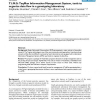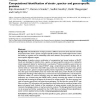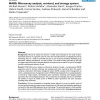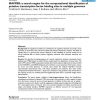BMCBI
2005
13 years 11 months ago
2005
Background: Single Nucleotide Polymorphism (SNP) genotyping is a major activity in biomedical research. The Taqman technology is one of the most commonly used approaches. It produ...
BMCBI
2005
13 years 11 months ago
2005
Background: We have developed the program PERMOL for semi-automated homology modeling of proteins. It is based on restrained molecular dynamics using a simulated annealing protoco...
BMCBI
2005
13 years 11 months ago
2005
Background: To date, 35 human diseases, some of which also exhibit anticipation, have been associated with unstable repeats. Anticipation has been reported in a number of diseases...
BMCBI
2005
13 years 11 months ago
2005
Background: Baum-Welch training is an expectation-maximisation algorithm for training the emission and transition probabilities of hidden Markov models in a fully automated way. I...
BMCBI
2005
13 years 11 months ago
2005
Background: Currently, the PDB contains approximately 29,000 protein structures comprising over 70,000 experimentally determined three-dimensional structures of over 5,000 differe...
BMCBI
2005
13 years 11 months ago
2005
Background: The availability of the human genome sequence as well as the large number of physically accessible oligonucleotides, cDNA, and BAC clones across the entire genome has ...
BMCBI
2005
13 years 11 months ago
2005
Background: The identification of unique proteins at different taxonomic levels has both scientific and practical value. Strain-, species- and genus-specific proteins can provide ...
BMCBI
2005
13 years 11 months ago
2005
Background: Microarray analysis has become a widely used technique for the study of geneexpression patterns on a genomic scale. As more and more laboratories are adopting microarr...
BMCBI
2005
13 years 11 months ago
2005
Background: Cis-regulatory modules are combinations of regulatory elements occurring in close proximity to each other that control the spatial and temporal expression of genes. Th...




